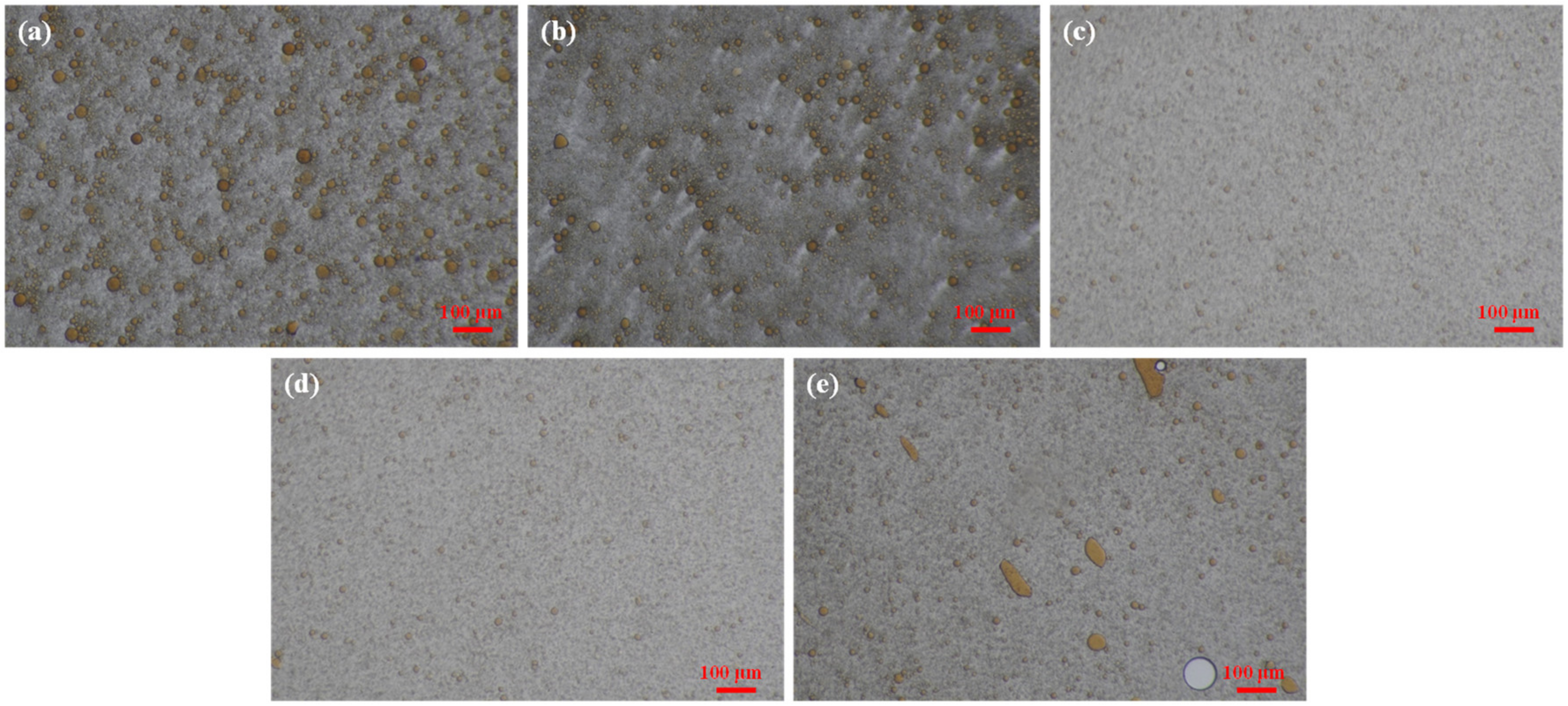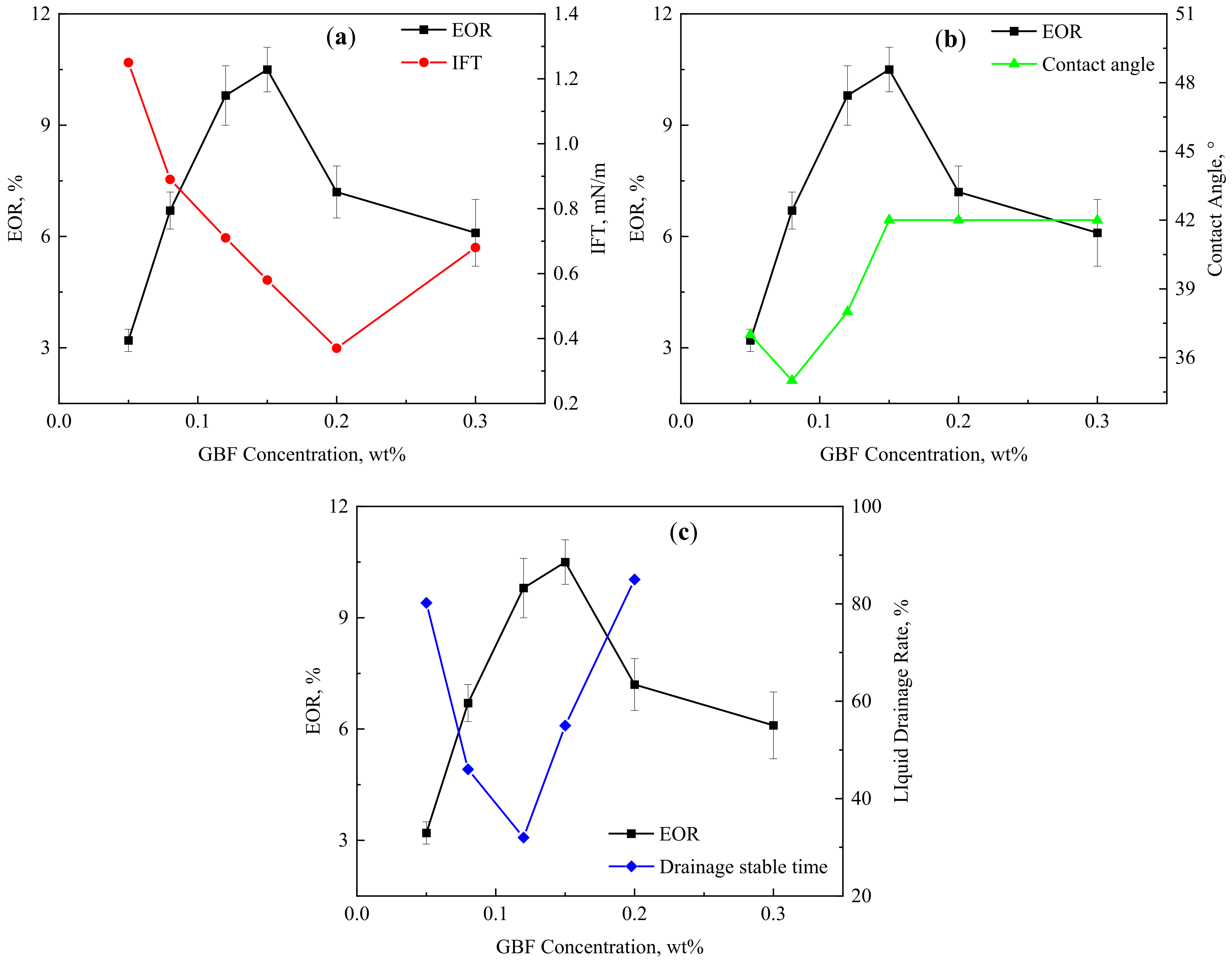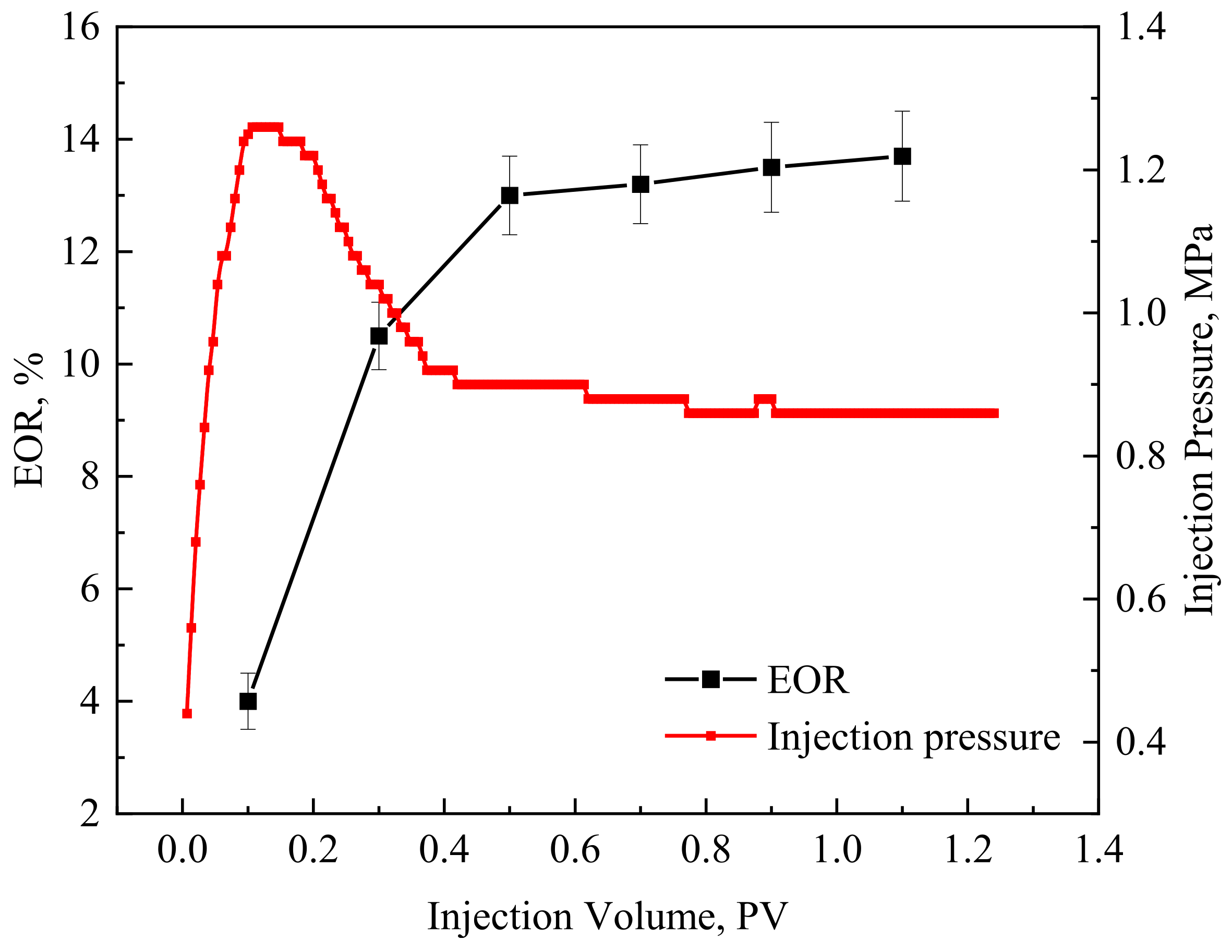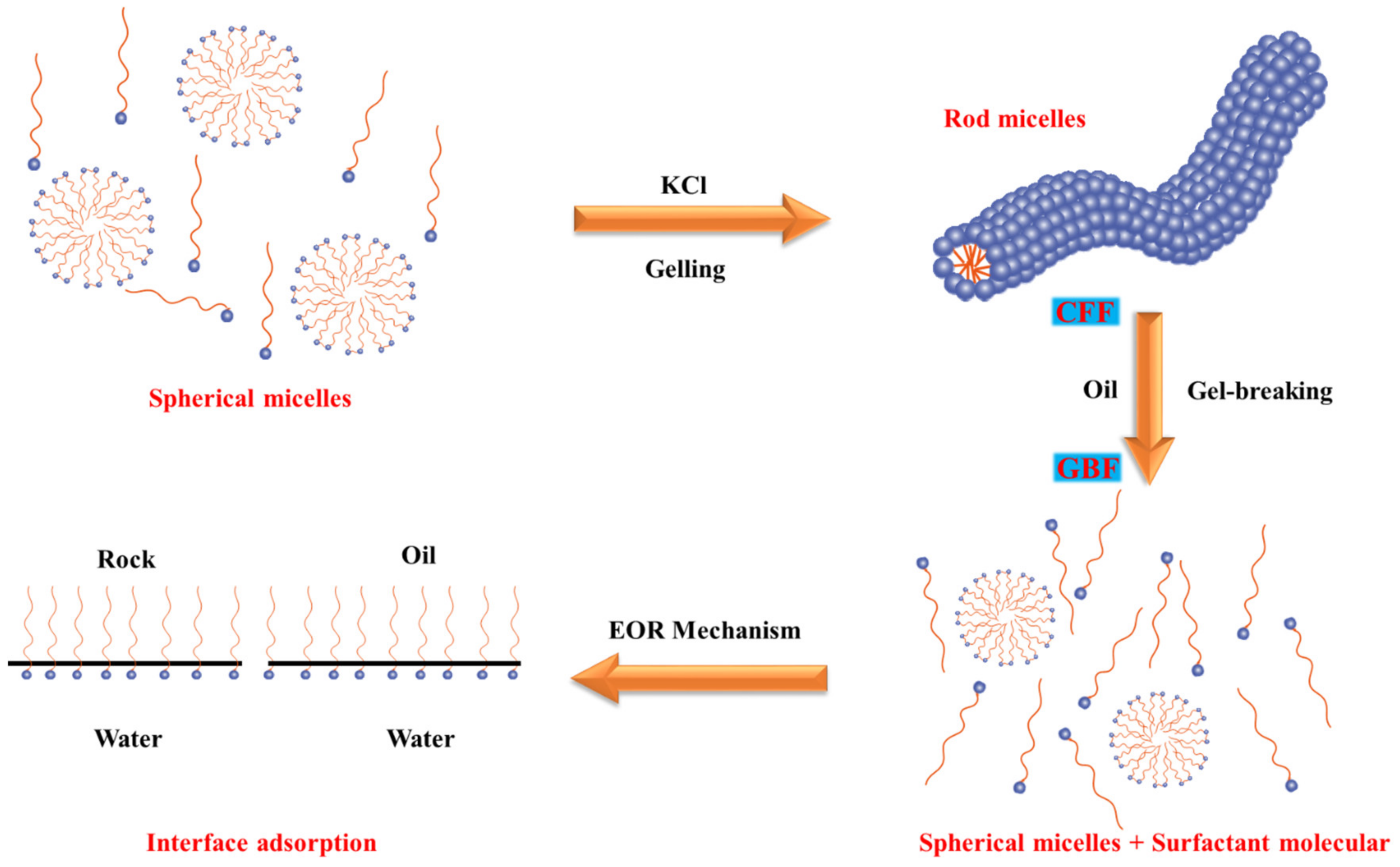Research on Performance Evaluation of Polymeric Surfactant Cleaning Gel-Breaking Fluid (GBF) and Its Enhanced Oil Recovery (EOR) Effect
Abstract
1. Introduction
2. Material and Method
2.1. Materials
2.2. Methods
2.2.1. Evaluation of Interfacial Tension
2.2.2. Evaluation of Wettability
2.2.3. Evaluation of Emulsion Ability
2.2.4. Core Displacement Experiments
3. Results and Discussion
3.1. IFT Reduction Ability of GBF
3.2. Wettability Alteration Ability of GBF
3.3. Emulsification Property of GBF
3.4. EOR Effect of GBF
3.5. Mechanism of GBF Formed Process and EOR Effect
4. Conclusions
- (1)
- GBFs can reduce the oil–water IFT to 10−1 mN/m. As the concentration of GBF increases, the oil–water IFT first decreases and then increases. The lowest IFT of 0.37 mN/m occurs when the GBF concentration is 0.20 wt%. The limited adsorption area of the oil–water interface and the long molecular chain are the main reasons that limit the continued IFT reduction.
- (2)
- GBFs can effectively improve reservoir wettability. As the concentration of GBF solution increases, the contact angle of the rock wall decreases from 129° and stabilizes at 42°. Reducing the oil–water IFT and changing the wettability of the reservoir are the fundamental reasons why GBFs can effectively strip crude oil from shale reservoirs.
- (3)
- GBFs have good emulsifying properties. As the concentration of GBF solution increases, the emulsion droplet size gradually decreases and stabilizes, with the smallest particle size at a concentration of 0.12–0.15 wt%. At a concentration of 0.20 wt%, a larger area of oil block will appear, which also corresponds to a significant reduction in emulsion stability.
- (4)
- The optimal application concentration of GBFs is 0.12–0.20 wt%, and the optimal injection volume is 0.5 PV. The oil displacement experiment shows that the concentration of GBF solution to obtain the best EOR effect is 0.15 wt%. At this concentration, the IFT reduction and the emulsification performance are not optimal. This shows that the IFT reduction performance, reservoir wettability change performance, and emulsification performance jointly determine the EOR effect of GBFs. In contrast, the emulsifying performance of GBFs is the main controlling factor for the EOR.
- (5)
- The experimental results of this paper prove that the BGF after breaking the CFF with a polymer surfactant as the main body has good EOR potential. It can effectively improve the oil washing efficiency and expand the swept volume at a lower dosage. Additionally, its main mechanism of action is emulsification rather than ultra-low interfacial tension, which also provides new thinking for the synthesis direction of oilfield chemicals.
Author Contributions
Funding
Institutional Review Board Statement
Data Availability Statement
Conflicts of Interest
References
- Burrows, L.C.; Haeri, F.; Cvetic, P.; Sanguinito, S.; Shi, F.; Tapriyal, D.; Goodman, A.; Enick, R.M. A literature review of CO2, natural gas, and water-based fluids for enhanced oil recovery in unconventional reservoirs. Energy Fuels 2020, 34, 5331–5380. [Google Scholar] [CrossRef]
- Malozyomov, B.V.; Martyushev, N.V.; Kukartsev, V.V.; Tynchenko, V.S.; Bukhtoyarov, V.V.; Wu, X.; Tyncheko, Y.A.; Kukartsev, V.A. Overview of Methods for Enhanced Oil Recovery from Conventional and Unconventional Reservoirs. Energies 2023, 16, 4907. [Google Scholar] [CrossRef]
- Yang, H.; Lv, Z.; Zhang, M.; Jiang, J.; Xu, B.; Shen, J.; Jiang, H.; Kang, W. A novel active amphiphilic polymer for enhancing heavy oil recovery: Synthesis, characterization and mechanism. J. Mol. Liq. 2023, 391, 123210. [Google Scholar] [CrossRef]
- Wang, W.; Xie, Q.; An, S.; Bakhshian, S.; Kang, Q.; Wang, H.; Xu, X.; Su, Y.; Cai, J.; Yuan, B. Pore-scale simulation of multiphase flow and reactive transport processes involved in geologic carbon sequestration. Earth-Sci. Rev. 2023, 247, 104602. [Google Scholar] [CrossRef]
- Zou, C.; Ma, F.; Pan, S.; Zhang, X.; Wu, S.; Fu, G.; Wang, H.; Yang, Z. Formation and distribution potential of global shale oil and the developments of continental shale oil theory and technology in China. Earth Sci. Front. 2023, 30, 128. [Google Scholar]
- Li, M.; Chen, X.; Wang, X. A Comparison of Geological Characteristics of the Main Continental Shale Oil in China and the US. Lithosphere 2021, 2021, 3377705. [Google Scholar] [CrossRef]
- Wang, X.; Li, J.; Jiang, W.; Zhang, H.; Feng, Y.; Yang, Z. Characteristics, current exploration practices, and prospects of continental shale oil in China. Adv. Geo-Energy Res. 2022, 6, 454–459. [Google Scholar] [CrossRef]
- He, W.; Zhu, R.; Cui, B.; Zhang, S.; Meng, Q.; Bai, B.; Feng, Z.; Lei, Z.; Wu, S.; He, K. The Geoscience Frontier of Gulong Shale Oil: Revealing the Role of Continental Shale from Oil Generation to Production. Engineering 2023, 28, 79–92. [Google Scholar] [CrossRef]
- Sun, L.; He, W.; Feng, Z.; Zeng, H.; Jiang, H.; Pan, Z. Shale oil and gas generation process and pore fracture system evolution mechanisms of the Continental Gulong Shale, Songliao Basin, China. Energy Fuels 2022, 36, 6893–6905. [Google Scholar] [CrossRef]
- Yang, Z.; Zou, C.; Wu, S.; Pan, S.; Wang, X.; Liu, H.; Jiang, W.; Li, J.; Li, Q.; Niu, X. Characteristics, types, and prospects of geological sweet sections in giant continental shale oil provinces in China. J. Earth Sci. 2022, 33, 1260–1277. [Google Scholar] [CrossRef]
- Zou, C.-N.; Yang, Z.; Hou, L.-H.; Zhu, R.-K.; Cui, J.-W.; Wu, S.-T.; Lin, S.-H.; Guo, Q.-L.; Wang, S.-J.; Li, D.-H. Geological characteristics and “sweet area” evaluation for tight oil. Pet. Sci. 2015, 12, 606–617. [Google Scholar] [CrossRef]
- Guo, T.; Zhang, S.; Qu, Z.; Zhou, T.; Xiao, Y.; Gao, J. Experimental study of hydraulic fracturing for shale by stimulated reservoir volume. Fuel 2014, 128, 373–380. [Google Scholar] [CrossRef]
- Tan, P.; Jin, Y.; Han, K.; Hou, B.; Chen, M.; Guo, X.; Gao, J. Analysis of hydraulic fracture initiation and vertical propagation behavior in laminated shale formation. Fuel 2017, 206, 482–493. [Google Scholar] [CrossRef]
- Cao, R.; Fang, S.; Jia, P.; Cheng, L.; Rao, X. An efficient embedded discrete-fracture model for 2D anisotropic reservoir simulation. J. Pet. Sci. Eng. 2019, 174, 115–130. [Google Scholar] [CrossRef]
- Rao, X.; Cheng, L.; Cao, R.; Jia, P.; Liu, H.; Du, X. A modified projection-based embedded discrete fracture model (pEDFM) for practical and accurate numerical simulation of fractured reservoir. J. Pet. Sci. Eng. 2020, 187, 106852. [Google Scholar] [CrossRef]
- Zhang, H.; Chen, J.; Zhao, Z.; Qiang, J. Hydraulic fracture network propagation in a naturally fractured shale reservoir based on the “well factory” model. Comput. Geotech. 2023, 153, 105103. [Google Scholar] [CrossRef]
- Montgomery, C. Fracturing Fluids. In Proceedings of the ISRM International Conference for Effective and Sustainable Hydraulic Fracturing, ISRM, Brisbane, Australia, 20–22 May 2013; p. ISRM-ICHF-2013-035. [Google Scholar]
- Huang, Q.; Liu, S.; Cheng, W.; Wang, G. Fracture permeability damage and recovery behaviors with fracturing fluid treatment of coal: An experimental study. Fuel 2020, 282, 118809. [Google Scholar] [CrossRef]
- Wang, J.; Huang, Y.; Zhang, Y.; Zhou, F.; Yao, E.; Wang, R. Study of fracturing fluid on gel breaking performance and damage to fracture conductivity. J. Pet. Sci. Eng. 2020, 193, 107443. [Google Scholar] [CrossRef]
- Guangyu, Y.; Jirui, H.; Huan, L. Current situation and development trend with respect to research and application of clean fracturing fluid. China Surfactant Deterg. Cosmet. 2012, 42, 288–292. [Google Scholar]
- Wang, C.; Zhou, G.; Jiang, W.; Niu, C.; Xue, Y. Preparation and performance analysis of bisamido-based cationic surfactant fracturing fluid for coal seam water injection. J. Mol. Liq. 2021, 332, 115806. [Google Scholar] [CrossRef]
- Yang, X.; Mao, J.; Zhang, H.; Zhang, Z.; Zhao, J. Reutilization of thickener from fracturing flowback fluid based on Gemini cationic surfactant. Fuel 2019, 235, 670–676. [Google Scholar] [CrossRef]
- Zhao, G.; Yan, Z.; Qian, F.; Sun, H.; Lu, X.; Fan, H. Molecular simulation study on the rheological properties of a pH-responsive clean fracturing fluid system. Fuel 2019, 253, 677–684. [Google Scholar] [CrossRef]
- Kang, W.; Mushi, S.J.; Yang, H.; Wang, P.; Hou, X. Development of smart viscoelastic surfactants and its applications in fracturing fluid: A review. J. Pet. Sci. Eng. 2020, 190, 107107. [Google Scholar] [CrossRef]
- Yang, Y.; Zhang, H.; Wang, H.; Zhang, J.; Guo, Y.; Wei, B.; Wen, Y. Pseudo-interpenetrating network viscoelastic surfactant fracturing fluid formed by surface-modified cellulose nanofibril and wormlike micelles. J. Pet. Sci. Eng. 2022, 208, 109608. [Google Scholar] [CrossRef]
- Huang, Q.; Liu, S.; Wu, B.; Wang, G.; Li, G.; Guo, Z. Role of VES-based fracturing fluid on gas sorption and diffusion of coal: An experimental study of Illinois basin coal. Process Saf. Environ. Prot. 2021, 148, 1243–1253. [Google Scholar] [CrossRef]
- Dantas, T.C.; Santanna, V.C.; Neto, A.D.; Neto, E.B.; Moura, M.A. Rheological properties of a new surfactant-based fracturing gel. Colloids Surf. A: Physicochem. Eng. Asp. 2003, 225, 129–135. [Google Scholar] [CrossRef]
- Legemah, M.; Guerin, M.; Sun, H.; Qu, Q. Novel high-efficiency boron crosslinkers for low-polymer-loading fracturing fluids. SPE J. 2014, 19, 737–743. [Google Scholar] [CrossRef]
- Chieng, Z.; Mohyaldinn, M.E.; Hassan, A.M.; Bruining, H. Experimental investigation and performance evaluation of modified viscoelastic surfactant (VES) as a new thickening fracturing fluid. Polymers 2020, 12, 1470. [Google Scholar] [CrossRef] [PubMed]
- Li, L.; Sun, Y.; Li, Y.; Wang, R.; Chen, J.; Wu, Y.; Dai, C. Interface properties evolution and imbibition mechanism of gel breaking fluid of clean fracturing fluid. J. Mol. Liq. 2022, 359, 118952. [Google Scholar] [CrossRef]
- Zhao, M.; Liu, S.; Gao, Z.; Wu, Y.; Dai, C. The spontaneous imbibition mechanisms for enhanced oil recovery by gel breaking fluid of clean fracturing fluid. Colloids Surf. A: Physicochem. Eng. Asp. 2022, 650, 129568. [Google Scholar] [CrossRef]
- Zhao, M.; Yan, X.; Cheng, Y.; Yan, R.; Dai, C. Study on the Imbibition Performance and Mechanism of a Fracturing Fluid and Its Gel Breaking Liquid. Energy Fuels 2022, 36, 13028–13036. [Google Scholar] [CrossRef]
- Chen, X.; Li, Y.; Sun, X.; Liu, Z.; Liu, J.; Liu, S. Investigation of Polymer-Assisted CO2 Flooding to Enhance Oil Recovery in Low-Permeability Reservoirs. Polymers 2023, 15, 3886. [Google Scholar] [CrossRef]
- Xie, Q.; Wang, W.; Su, Y.; Wang, H.; Zhang, Z.; Yan, W. Pore-scale study of calcite dissolution during CO2-saturated brine injection for sequestration in carbonate aquifers. Gas Sci. Eng. 2023, 114, 204978. [Google Scholar] [CrossRef]
- Du, M.; Sun, X.; Dai, C.; Li, H.; Wang, T.; Xu, Z.; Zhao, M.; Guan, B.; Liu, P. Laboratory experiment on a toluene-polydimethyl silicone thickened supercritical carbon dioxide fracturing fluid. J. Pet. Sci. Eng. 2018, 166, 369–374. [Google Scholar] [CrossRef]
- Isaac, O.T.; Pu, H.; Oni, B.A.; Samson, F.A. Surfactants employed in conventional and unconventional reservoirs for enhanced oil recovery—A review. Energy Rep. 2022, 8, 2806–2830. [Google Scholar] [CrossRef]
- Chen, X.; Li, Y.; Liu, Z.; Li, X.; Zhang, J.; Zhang, H. Core-and pore-scale investigation on the migration and plugging of polymer microspheres in a heterogeneous porous media. J. Pet. Sci. Eng. 2020, 195, 107636. [Google Scholar] [CrossRef]
- Chen, X.; Li, Y.; Liu, Z.; Tang, Y.; Sui, M. Visualized investigation of the immiscible displacement: Influencing factors, improved method, and EOR effect. Fuel 2023, 331, 125841. [Google Scholar] [CrossRef]
- Chen, X.; Li, Y.-Q.; Liu, Z.-Y.; Gao, W.-B.; Sui, M.-Y. Experimental investigation on the enhanced oil recovery efficiency of polymeric surfactant: Matching relationship with core and emulsification ability. Pet. Sci. 2023, 20, 619–635. [Google Scholar] [CrossRef]
- Chen, X.; Li, Y.; Liu, Z.; Zhang, J.; Chen, C.; Ma, M. Investigation on matching relationship and plugging mechanism of self-adaptive micro-gel (SMG) as a profile control and oil displacement agent. Powder Technol. 2020, 364, 774–784. [Google Scholar] [CrossRef]
- Chen, X.; Li, Y.; Liu, Z.; Zhang, J.; Li, X. Experimental and theoretical investigation of the migration and plugging of the particle in porous media based on elastic properties. Fuel 2023, 332, 126224. [Google Scholar] [CrossRef]
- Yang, H.; Lv, Z.; Li, Z.; Guo, B.; Zhao, J.; Xu, Y.; Xu, W.; Kang, W. Laboratory evaluation of a controllable self-degradable temporary plugging agent in fractured reservoir. Phys. Fluids 2023, 35, 083314. [Google Scholar] [CrossRef]
- Wang, Y.; Xu, H.; Yu, W.; Bai, B.; Song, X.; Zhang, J. Surfactant induced reservoir wettability alteration: Recent theoretical and experimental advances in enhanced oil recovery. Pet. Sci. 2011, 8, 463–476. [Google Scholar] [CrossRef]
- Giraldo, J.; Benjumea, P.; Lopera, S.; Cortés, F.B.; Ruiz, M.A. Wettability alteration of sandstone cores by alumina-based nanofluids. Energy Fuels 2013, 27, 3659–3665. [Google Scholar] [CrossRef]
- Hou, J.; Sun, L. Synergistic effect of nanofluids and surfactants on heavy oil recovery and oil-wet calcite wettability. Nanomaterials 2021, 11, 1849. [Google Scholar] [CrossRef]
- Karimi, A.; Fakhroueian, Z.; Bahramian, A.; Pour Khiabani, N.; Darabad, J.B.; Azin, R.; Arya, S. Wettability alteration in carbonates using zirconium oxide nanofluids: EOR implications. Energy Fuels 2012, 26, 1028–1036. [Google Scholar] [CrossRef]
- Yekeen, N.; Padmanabhan, E.; Syed, A.H.; Sevoo, T.; Kanesen, K. Synergistic influence of nanoparticles and surfactants on interfacial tension reduction, wettability alteration and stabilization of oil-in-water emulsion. J. Pet. Sci. Eng. 2020, 186, 106779. [Google Scholar] [CrossRef]
- Keykhosravi, A.; Simjoo, M. Enhancement of capillary imbibition by Gamma-Alumina nanoparticles in carbonate rocks: Underlying mechanisms and scaling analysis. J. Pet. Sci. Eng. 2020, 187, 106802. [Google Scholar] [CrossRef]
- Kuang, W.; Saraji, S.; Piri, M. A systematic experimental investigation on the synergistic effects of aqueous nanofluids on interfacial properties and their implications for enhanced oil recovery. Fuel 2018, 220, 849–870. [Google Scholar] [CrossRef]
- Sun, Y.-P.; Xin, Y.; Lyu, F.-T.; Dai, C.-L. Experimental study on the mechanism of adsorption-improved imbibition in oil-wet tight sandstone by a nonionic surfactant for enhanced oil recovery. Pet. Sci. 2021, 18, 1115–1126. [Google Scholar] [CrossRef]
- Tian, W.; Wu, K.; Gao, Y.; Chen, Z.; Gao, Y.; Li, J. A critical review of enhanced oil recovery by imbibition: Theory and practice. Energy Fuels 2021, 35, 5643–5670. [Google Scholar] [CrossRef]
- Xu, D.; Li, Z.; Bai, B.; Chen, X.; Wu, H.; Hou, J.; Kang, W. A systematic research on spontaneous imbibition of surfactant solutions for low permeability sandstone reservoirs. J. Pet. Sci. Eng. 2021, 206, 109003. [Google Scholar] [CrossRef]
- Yuan, C.; Pu, W.; Wang, X.; Sun, L.; Zhang, Y.; Cheng, S. Effects of interfacial tension, emulsification, and surfactant concentration on oil recovery in surfactant flooding process for high temperature and high salinity reservoirs. Energy Fuels 2015, 29, 6165–6176. [Google Scholar] [CrossRef]
- Guo, H.; Li, Y.; Wang, F.; Gu, Y. Comparison of strong-alkali and weak-alkali ASP-flooding field tests in Daqing oil field. SPE Prod. Oper. 2018, 33, 353–362. [Google Scholar] [CrossRef]
- Musevic, I.; Skarabot, M.; Tkalec, U.; Ravnik, M.; Zumer, S. Two-dimensional nematic colloidal crystals self-assembled by topological defects. Science 2006, 313, 954–958. [Google Scholar] [CrossRef]
- Davies, T.; Ketner, A.; Raghavan, S. Self-assembly of surfactant vesicles that transform into viscoelastic wormlike micelles upon heating. J. Am. Chem. Soc. 2006, 128, 6669–6675. [Google Scholar] [CrossRef]








| Iron | K+, Na+ | Ca2+ | Mg2+ | CO32− | HCO3− | SO42− | Cl− | Total |
|---|---|---|---|---|---|---|---|---|
| Concentration, mg/L | 12,429.68 | 1110.17 | 637.88 | 57.12 | 1252.12 | 342.86 | 21,853.51 | 37,683 |
| Core | Pore Volume, mL | Diameter, cm | Length, cm | Permeability, mD | Volume of Oil, mL | Oil Saturation, % |
|---|---|---|---|---|---|---|
| C1 | 6.8 | 2.5 | 7.1 | 7.5 | 4.9 | 72.06 |
| C2 | 7.1 | 2.5 | 7.2 | 8.3 | 5.2 | 73.24 |
| C3 | 6.3 | 2.5 | 6.8 | 7.2 | 4.5 | 71.43 |
| C4 | 6.5 | 2.5 | 6.9 | 7.5 | 4.7 | 72.31 |
| C5 | 6.7 | 2.5 | 7.0 | 7.7 | 4.9 | 73.13 |
| C6 | 6.7 | 2.5 | 7.1 | 7.8 | 4.7 | 70.15 |
| C7 | 6.9 | 2.5 | 7.1 | 7.9 | 4.9 | 71.01 |
| Number | Core | GBF Concentration, wt% | GBF Volume, PV | Injection Process | Note |
|---|---|---|---|---|---|
| 1 | C1 | 0.05 | 0.3 | Water flooding to the water cut reaches 90%—GBF flooding to designed volume | Compare the influence of GBF concentration |
| 2 | C2 | 0.08 | 0.3 | ||
| 3 | C3 | 0.12 | 0.3 | ||
| 4 | C4 | 0.15 | 0.3 | ||
| 5 | C5 | 0.20 | 0.3 | ||
| 6 | C6 | 0.30 | 0.3 | ||
| 7 | C7 | 0.15 | 1.2 | Compare the influence of GBF volume |
| Number | Agent | Concentration, wt% | IFT, mN/m | Volume, PV | Recovery, % | EOR, % |
|---|---|---|---|---|---|---|
| 0 | Gel-breaking fluid | 0.15 | 0.46 | 0.5 | 58.32 | 13.00 |
| 1 [30] | Gel-breaking fluid | 0.70 | 0.369 | Imbibition | 33.20 | / |
| 2 [31] | Gel-breaking fluid | 2.00 | 0.14 | Imbibition | 40.00 | / |
| 3 [39] | Polymeric surfactant | 1.50 | ~0.90 | 0.8 | / | 17.49 |
| 4 [53] | Compound surfactant | / | 10−2 | 3 | / | 13.65 |
| 5 [53] | Compound surfactant | / | 10−3 | 3 | / | 16.28 |
| 6 [54] | ASP (Alkali + Surfactant + Polymer) | S is 0.1–0.3 | ~10−2 | 0.5–0.8 | / | 18–28 |
Disclaimer/Publisher’s Note: The statements, opinions and data contained in all publications are solely those of the individual author(s) and contributor(s) and not of MDPI and/or the editor(s). MDPI and/or the editor(s) disclaim responsibility for any injury to people or property resulting from any ideas, methods, instructions or products referred to in the content. |
© 2024 by the authors. Licensee MDPI, Basel, Switzerland. This article is an open access article distributed under the terms and conditions of the Creative Commons Attribution (CC BY) license (https://creativecommons.org/licenses/by/4.0/).
Share and Cite
Liao, Y.; Jin, J.; Du, S.; Ren, Y.; Li, Q. Research on Performance Evaluation of Polymeric Surfactant Cleaning Gel-Breaking Fluid (GBF) and Its Enhanced Oil Recovery (EOR) Effect. Polymers 2024, 16, 397. https://doi.org/10.3390/polym16030397
Liao Y, Jin J, Du S, Ren Y, Li Q. Research on Performance Evaluation of Polymeric Surfactant Cleaning Gel-Breaking Fluid (GBF) and Its Enhanced Oil Recovery (EOR) Effect. Polymers. 2024; 16(3):397. https://doi.org/10.3390/polym16030397
Chicago/Turabian StyleLiao, Yubin, Jicheng Jin, Shenglin Du, Yufei Ren, and Qiang Li. 2024. "Research on Performance Evaluation of Polymeric Surfactant Cleaning Gel-Breaking Fluid (GBF) and Its Enhanced Oil Recovery (EOR) Effect" Polymers 16, no. 3: 397. https://doi.org/10.3390/polym16030397
APA StyleLiao, Y., Jin, J., Du, S., Ren, Y., & Li, Q. (2024). Research on Performance Evaluation of Polymeric Surfactant Cleaning Gel-Breaking Fluid (GBF) and Its Enhanced Oil Recovery (EOR) Effect. Polymers, 16(3), 397. https://doi.org/10.3390/polym16030397







